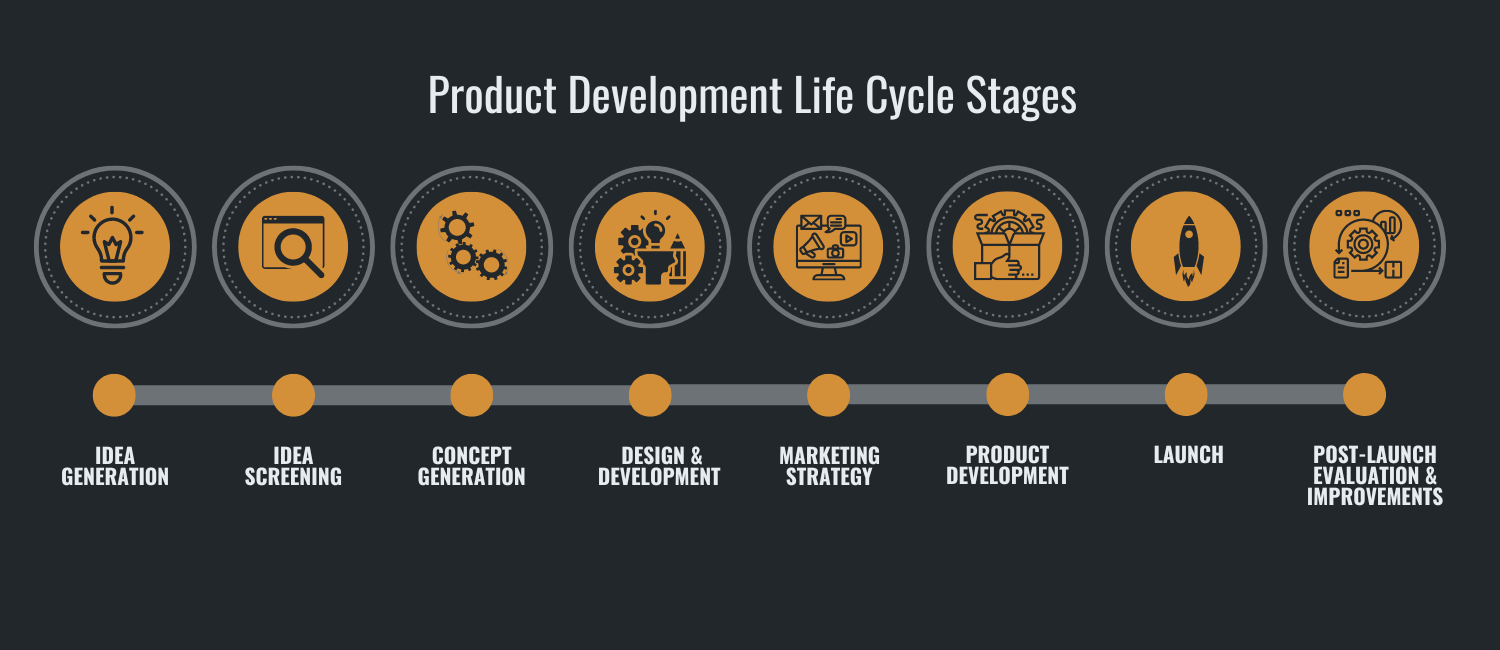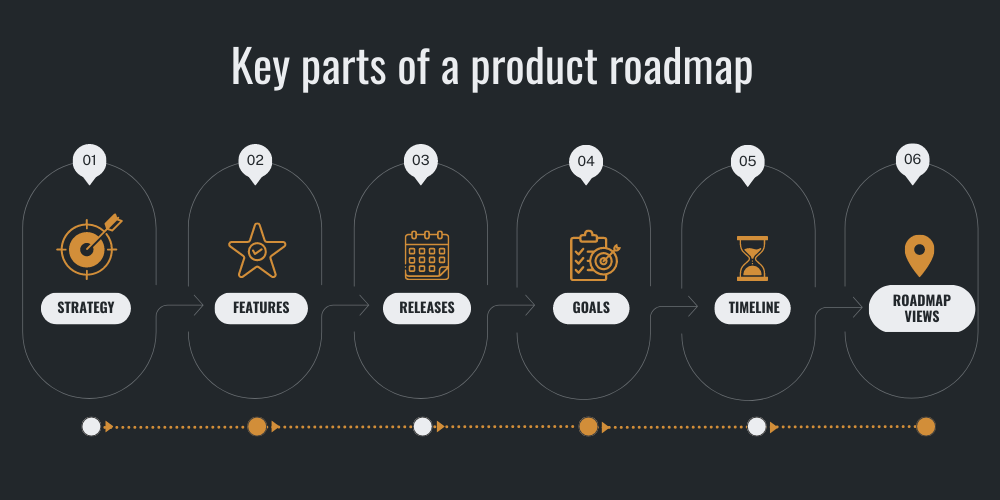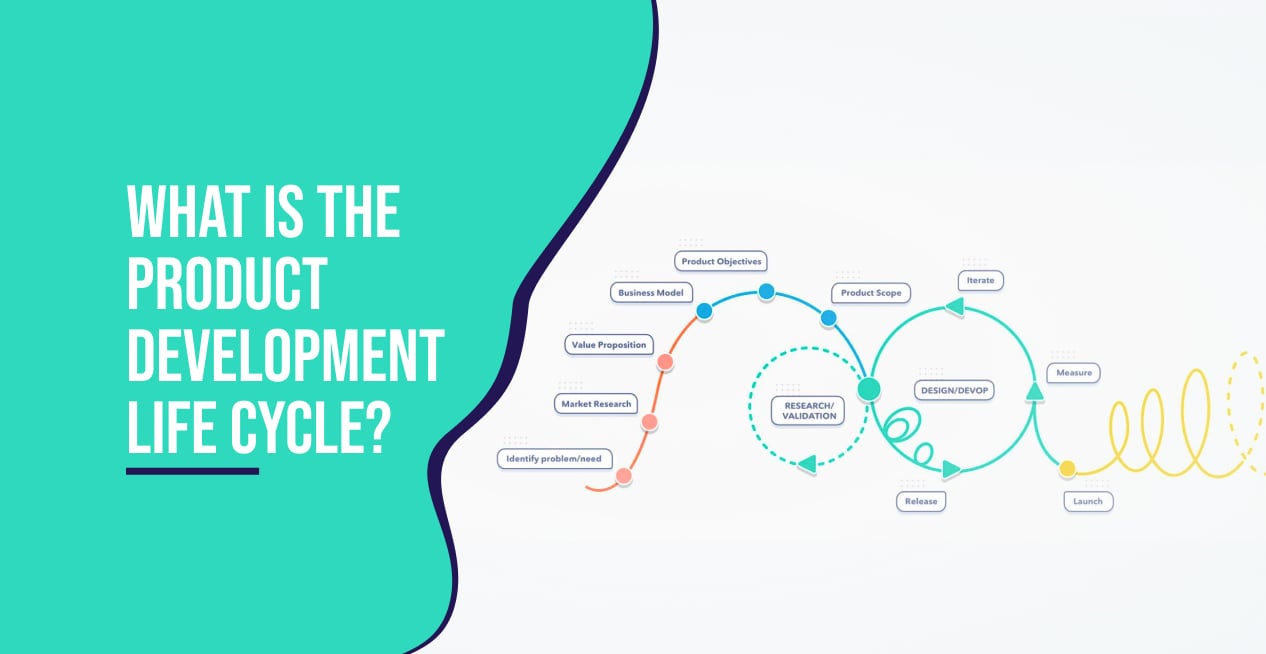-
Introduction
- What is the Product Development Life Cycle?
-
Why do companies require a Product Development Process?
- What are the Product Development Life Cycle stages?
-
PDLC vs SDLC: What’s the difference?
-
Example of the Product development process:
-
Advantages of using the product development life cycle
-
Disadvantages of using the product development life cycle
-
Conclusions
- Faqs:
Introduction
Market and customers are the two sides of the same coin. They keep on evolving. New requirements enter the market, and the old standards of service need to respond to expectations. Naturally, products and software solutions can’t remain static – they must adapt to retain market dominance.
A product development life cycle takes account of all these changes, whereas the team should be prepared to change its strategy initially. Because of this, the algorithm flow implemented in product development consists of multiple steps.
If you’re planning to launch a new product to the market, it’s good to be aware of the new product development life cycle. Implementing this popular method will help you develop an effective product ready for the trending market.
What is the Product Development Life Cycle?
When a product is born, it is vital to specify what, when, and how it will undergo several phases. The concept of the Product Development Life Cycle (PDLC) was developed by marketing researchers and executives.
According to the concept of the Product Life Cycle, each product goes through a set of stages as it develops. The process is broken down into four periods: introduction, growth, maturity, and decline.
In the same way as product development starts, a product needs to pass through several stages in its life cycle, starting with its initial conception and ending with its eventual removal from the market. The stages of the product development life cycle can vary from organization to industry.
Difference Between: Product Life Cycle v/s Product Development Life Cycle
The Product Life Cycle (PLC) and the Product Development Life Cycle (PDLC) are related but have distinct concepts;
- PDLC focuses on the planning, discovery, development, and evaluation of a product whereas PLC examines the market performance and market share of the product.
- The stages a product goes through, from its initial conception to its eventual withdrawal from the market, is referred to as the PDLC. On the contrary, if a product goes through its introduction to its eventual removal from the market is referred to as PLC.
- The stages of the PDCL differ depending on the organization and the industry. It includes idea generation, concept development, design and development, testing and development, product launch, and post-launch evaluations. The phases included in PLC are introduction, growth, maturity, and decline.
- PDLC focuses on the stages of product development & creation before it enters the market. PLC focuses on the stages of the product’s existence in the market.
Are Product Management and Product Development the same?
Product development and management are not the same.
Product management is a process of overseeing the development and life cycle of a product, from concept to retirement. This includes identifying customer needs & market opportunities, setting product strategy, defining requirements, and working with cross-functional teams to bring the product to the market.
Contrarily, product development is the actual procedure of developing, producing, and testing the product. A group of engineers, designers, and other experts usually collaborate to translate an idea into a tangible product that can be sold to a customer.
Why do companies require a Product Development Process?
- Companies require a product development process to ensure that their product is developed efficiently & with the requirements of customers in mind.
- This procedure mandates the creation of a product from its first concept until its launch.
- It helps to ensure that all necessary steps are taken & that the potential problems are identified & addressed at an early stage.
- It allows better communication & collaboration between all the parties involved in the development process.
- This process also ensures that the final product meets or exceeds the expectations & requirements of the clients.

What are the Product Development Life Cycle stages?

Building new products or services can be a difficult process filled with uncertainties and risks. Therefore, a systematic approach must be followed to ensure that businesses gain certain clarity & confidence for building the product.
Stage 1: Idea Generation
Ideation is the most important stage of a product development life cycle. The major focus is brainstorming sessions. This stage involves identifying potential product opportunities and generating ideas for new products. Customers’ problems are given top emphasis at this level.
The goal of this stage is not to come up with solid, workable ideas. Instead, raw ideas or preliminary sketches can be put into practice later. The shortlisted ideas can then be discussed and altered.
The SCAMPER approach is the simplest way to surface opportunities in this particular phase. This well-known strategy is described as unlocking the creative doors in your head. It gives you the freedom to think creatively and helps you rethink the product or service. The acronym instructs entrepreneurs to Substitute, Combine, Adapt, Modify, Put to other use, Eliminate, or Reverse each element of a given product.
Market research, competitive analysis, or simply listening to current customers can all be useful to generate ideas. Think about how you might take advantage of changes in consumer behavior, unfulfilled demands, or new technology to gain a competitive edge.
Stage 2: Idea Vetting/Screening
This is the stage wherein the ideas collected with the highest potential for success are selected. All ideas are internally reviewed by individuals with industry expertise & experience in idea screening analysis.
Hire an expert Product Manager from OpenXcell. Their expertise can help with understanding the technical side of things, which can help to narrow down the list of ideas that are worth building.
SWOT analysis is a common technique for narrowing down product development ideas (Strengths, Weaknesses, Opportunities, and Threats). In this specific strategy, product managers thoroughly analyze an idea to find one where possibilities and strengths outweigh threats and shortcomings.
Stage 3: Concept Generation
Concept generation is the stage where initial ideas for a product are generated and evaluated. This stage is crucial for determining the feasibility and potential success of a product, as well as identifying potential issues that may need to be addressed later in the product development process.
Additionally, concept development helps to define the product’s specifications and features, which will guide the design & development stages that follow. Overall, concept development includes market research, feasibility studies, and cost-benefit analysis. It helps to ensure that resources are being allocated effectively and the final product will meet the needs of the targetted market.
Stage 4: Design & Development
After choosing a product idea, the next stage is to design and develop the product. The
process starts with determining the key features & functions that are needed to be added. This stage includes creating detailed specifications, engineering drawings, & prototypes. Now, a mockup or working model of the product is created using wireframing tools like a sketch. This enables us to visualize how the final product will look, feel, and function.
After completion of product design & development, it is necessary to gather feedback inputs from experts & potential customers. It paves the way to get an open-book review about the design & expected functionality of the product. If the testers give the green flags, this will give us the confidence to invest in the next steps. Alternatively, if some loopholes are found, then going back to the drawing board to streamline the user experience becomes necessary.
Stage 5: Marketing Strategy
With the completion of design & development, there comes marketing strategy. This strategy focuses on reaching our targeted audience. It helps to identify customers’ needs & preferences, conduct market research, and develop a go-to-market strategy. This information is used to guide the product development process and ensure that the final product meets the needs of the target market.
After conducting market research, determine the platforms you’ll employ to fuel your sales funnel. This includes emailers, paid advertising, social media, and many other channels. Consider which channel of marketing is best suited for your product type.
Marketing helps create hype and interest in the product prior to and during a product’s launch.
Stage 6: Product Development
The market strategy is documented and the business analysis is also completed. Now comes the time to move towards the product life cycle development process. The process starts with the development of your minimum viable product (MVP). The bare minimum version of the product is introduced to the market. The objective is to reach the market as soon as feasible. Future versions are dependent on the users’ initial response.

When the development team starts to launch the product, creating a product roadmap can assist you with any functionality. The 80/20 method can be used to prioritize future updates. As a result, you must concentrate on the 20% of enhancements that will affect user experience.
Stage 7: Launch
A week before the launch, one must check if everything is in the right place and running smoothly or not. In terms of the product, this entails concluding integrations, establishing billing, and putting user monitoring and analytics. Explore every nook and cranny of the product, testing it across various platforms, browsers, user flows, and edge cases.
Concurrently, finish off your marketing campaigns. Make a splash on social media, organize a launch event, and schedule press releases. When finally the time arrives, seize the moment and go live. Enjoy the excitement, buzz, and sense of accomplishment that comes with the launch of your new product.
Take a step back and look around to see how everything works. Analyze consumer demand, monitor usage, and pay close attention to who signs up. Examine how customers use the product, what features they like, and any areas that could be made better. Launch day is always exciting, but it’s merely the beginning. The seventh and final stage of the product development life cycle never ends.
Stage 8: Post-launch Evaluation & Improvements
The road to product development is long, and you can’t get to a destination right away. If all things are equal, the most important feedback will guide you with further steps. After the product has been launched, it is assessed to determine how well it is performing in the market and to find areas where it may be improved.
At this point, the product roadmap enters the picture, allowing you to modify the current features and add new ones. It will be helpful for you if you go back and review stages one through six to ensure that each update delights users.
Another resource for product data is gathering customer feedback directly. Send survey forms to existing users. You can use these insights to comprehend better why customers aren’t utilizing your product or what improvements need to be done to enhance the customer experience.
Turning an idea into a completed product reality ain’t an easy process. One must be careful while planning and executing at every turn. The product development lifecycle is an ongoing process of research, implementation, and improvement. By comprehending each step and its goals, you can take a product from idea to launch & beyond.
The most crucial advice is to stay flexible & adaptable to the feedback from customers and keep an eagle eye on price graphs.
Note: Not all organizations will have all of these stages and the names of stages may vary but the overall process is the same.
PDLC vs SDLC: What’s the difference?
PDLC (Product Development Lifecycle) and SDLC (Software Development Lifecycle) are two different methodologies for managing the development of a product or software. These two terms sometimes are mistakenly interchanged but they have completely different meanings. Because of this, it’s crucial to understand how unique each one is;
| PDLC | SDLC |
| PDLC is a model for managing the entire process of creating a new product, from initial concept to end-of-life. | SDLC is a specific methodology for managing the development of software. |
| It typically includes the stages of idea generation, feasibility, analysis, design, development, testing & launch. | This typically includes stages such as requirements gathering, design, development, testing & maintenance. |
| It is more focused on product development. | It is more focused on software development. |
| PDLCs are deliverable in a physical form as a product or service. | SDLC’s deliverable is software. |
| It may take a longer time frame than SDLC as it involves the entire product development process. | SDLC is focused solely on software development, which can be done relatively quickly. |
| PDLC requires a more holistic approach, taking into account factors like market research, customer needs & competitive analysis. | The SDLC places a greater emphasis on the technical aspects of software, such as coding, testing, and fixing bugs. |
| The goal of PDLC is to develop products that meet consumer demands. | The SDLC is focused on developing software that satisfies the needs of clients or end-user |

Example of the Product development process:
Let us dive deep into the example to gain a better grasp of how the product development process operates;
a) A software development company develops a new app for smartphones. The process begins with identifying a market opportunity or a customer need. This is the “ideation” phase of the product development process.
b) Next, the company conducts user research, market analysis, and competitive analysis. This is the ‘Research & Analysis” phase, where the company defines the target market, user personas, and product requirements.
c) Once the research is complete, the company enters the “Design” phase, where the app’s user interface and user experience are created. This includes creating wireframes, mock-ups, and prototypes.
d) After the design is finalized, the company enters the “Development” phase, where the app is built and coded. This includes testing and debugging the app to ensure it meets all technical requirements.
e) Once the app is ready, it is launched and made available to customers. This is the “Launch” phase, where the company releases the app to the app store and promotes it through various marketing channels.
f) Finally, the company enters the “Post-Launch” phase, where they monitor the app’s performance, gather feedback, and make improvements to the product. They may also release updates and new versions of the app.
Have an idea but are unsure about how to make it work? Reach us OpenXcell, the leading Software Product Development Company in India & USA.
Advantages of using the product development life cycle
Product development life cycle is a great technique that can be used by organizations to smoothen the procedure of developing a product. It allows you to go in the right direction without any deviations of thoughts.
Here are a few advantages of how the product development life cycle can be advantageous to you;
- Improved planning & organization: The product development process provides a structured approach to developing new products, which can help to improve planning and organization.
- Reduced risk of failure: By following the structured process, the risk of product failure can be reduced, as it follows through research, testing and development.
- Increased efficiency: The product development process can help to improve the efficiency of product development, as it provides a clear roadmap for the development of new products.
- Improved communication: This process helps to improve communication between different departments and stakeholders, as it provides a common language and framework for discussing product development.
- Increased customer satisfaction: By involving the customer in the product development process, it is possible to ensure that the product meets the needs and wants of the target market, which can lead to increased customer satisfaction.
- Better testing: The product development process allows for thorough testing of the product before release, which can help to identify any bugs, defects, or issues before the product is released to the market.
- Better adaptability: The product development process allows for a more flexible approach to product development, as it allows for changes based on the market condition or customer feedback.
Disadvantages of using the product development life cycle
The product development life cycle has an array of benefits but also a few limitations. Even though it has certain advantages in decision-making the disadvantages can definitely not be neglected.
Here are a few limitations you may encounter during the process of product development, which may require proper mitigation measures to succeed:
- High cost: The product development process can be costly, especially in the early stages of research and development.
- Time-consuming: The development process can take a significant amount of time, which can delay the introduction of new products to the market.
- Risk of failure: There is always a risk that a product will not be successful, which can result in financial losses for the company.
- Limited flexibility: The product development process can be rigid and inflexible, making it difficult to respond to changes in the market or customer needs.
- Limited creativity: The process can stifle creativity and innovation, as it focuses on following a set of predetermined steps.
- Limited customer involvement: The product development process may not involve the customer early enough, resulting in a product that does not meet the needs or wants of the target market.
- Limited testing: Limited testing may result in a product that has bugs, defects, or does not work as intended.
Conclusions
The eight stages of the product development lifecycle are important for businesses as they go about creating & maintaining software products. Each process provides an opportunity for businesses to ensure customer satisfaction by considering their needs and wants.
It helps in comprehending a product’s current stage and foreseeing any potential future changes or client requirements. Companies can, hence, obtain a competitive edge by controlling the various PDLC points proactively thereby staying ahead of the market trends.

Faqs:
1. What is the need for Product Development?
Product development is an essential process for businesses because it helps them to meet customer needs, stay competitive, increase revenue, improve efficiency, respond to market changes, encourage innovation, enhance brand image and make the most of opportunities.
2. What are some of the Product Development ideas?
The most effective ideas depend on the specific industry, target market, and company. For example;
- Creating; a subscription-based model where customers pay a recurring fee to access the product or service.
- Incorporating; new technologies like AI, loT, blockchain, etc. to make products more advanced, efficient & reliable.
- Developing; a service that complements a product, for example, offering installation or maintenance services for a product.
- Improving; existing products by adding new features or functionality.
- Customizing a product to meet the specific needs of a particular market.
3. What are the different types of Product Development?
There are several types of product development, including new product development, product improvement, product customization, product diversification, product line extension, and repositioning.
4. Who is part of the product development team?
A product development team typically includes a variety of individuals with different roles and responsibilities. This includes product managers, product designers, engineers, quality assurance, project managers, marketing and sales, business analysts, etc.








